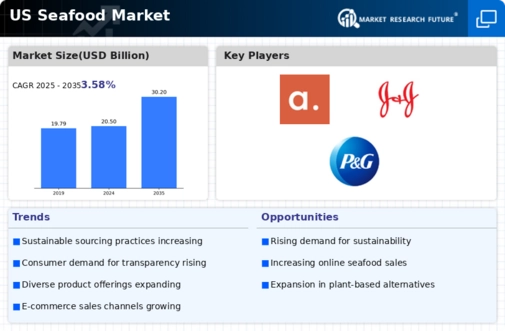Rising Demand for Seafood Products
The seafood market in the US is experiencing a notable increase in demand, driven by a growing consumer preference for protein-rich diets. Recent data indicates that seafood consumption has risen by approximately 15% over the past five years, reflecting a shift towards healthier eating habits. This trend is further supported by the increasing awareness of the nutritional benefits associated with seafood, such as omega-3 fatty acids and essential vitamins. As consumers become more health-conscious, the seafood market is likely to benefit from this rising demand, leading to potential growth opportunities for suppliers and retailers. Additionally, the expansion of seafood offerings in restaurants and grocery stores is expected to cater to this evolving consumer preference, thereby enhancing market dynamics.
Expansion of Seafood Distribution Channels
The seafood market is witnessing an expansion of distribution channels, which is crucial for meeting the diverse needs of consumers. The rise of online grocery shopping and delivery services has transformed how seafood products reach consumers, with e-commerce sales in the seafood sector increasing by approximately 20% in the last year. This shift is likely to enhance accessibility and convenience for consumers, thereby driving sales growth. Additionally, partnerships between seafood suppliers and retailers are becoming more common, facilitating better product placement and promotion. As distribution channels continue to evolve, the seafood market is expected to benefit from improved logistics and supply chain management, ultimately leading to increased market penetration.
Growing Interest in Sustainable Seafood Options
Consumer interest in sustainability is becoming a pivotal driver for the seafood market in the US. As awareness of overfishing and environmental concerns rises, many consumers are actively seeking sustainably sourced seafood products. Reports suggest that approximately 30% of seafood consumers prioritize sustainability when making purchasing decisions. This trend is prompting retailers and suppliers to adopt sustainable sourcing practices, which may enhance their brand reputation and appeal to environmentally conscious consumers. The seafood market is likely to see a surge in demand for certified sustainable products, which could lead to new market opportunities and partnerships within the industry.
Technological Advancements in Seafood Processing
Innovations in seafood processing technology are significantly impacting the seafood market in the US. Advanced techniques such as high-pressure processing and improved freezing methods are enhancing product quality and shelf life, which may lead to increased consumer trust and satisfaction. Furthermore, these technologies can reduce waste and improve efficiency in production, potentially lowering costs for manufacturers. As a result, the seafood market is likely to see a rise in the availability of high-quality products, which could attract a broader customer base. The integration of automation and artificial intelligence in processing facilities is also expected to streamline operations, thereby contributing to the overall growth of the market.
Influence of Culinary Trends on Seafood Consumption
Culinary trends are playing a significant role in shaping the seafood market in the US. The increasing popularity of international cuisines, particularly those featuring seafood, is driving consumer interest and consumption. For instance, dishes such as poke bowls and seafood tacos have gained traction, leading to a broader acceptance of various seafood types. This culinary evolution may encourage consumers to experiment with different seafood products, thereby expanding the market. Additionally, the rise of food influencers and social media platforms is likely to amplify these trends, as consumers seek inspiration for seafood recipes. As culinary preferences continue to evolve, the seafood market is expected to adapt, potentially leading to innovative product offerings and marketing strategies.














Leave a Comment